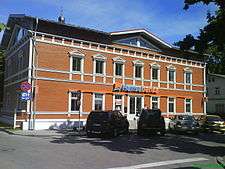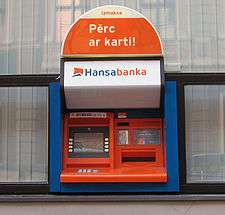Hansabank


Hansabank was a bank operating in Estonia, Latvia, and Lithuania owned by the FöreningsSparbanken/Swedbank, a Swedish bank. Following a decision taken by the Swedbank group on 15 September 2008, the Hansabank name was discontinued in 2009 with all operations rebranded under the Swedbank name.[1]
Origins
The history of the Hansabank Group dates back to 1 July 1991 when Hansapank started operating as a branch of Tartu Kommertspank (Tartu Commercial Bank) in Estonia. Officially Hansapank launched independent operations on 10 January 1992. Hansabank was founded in Estonia by Hannes Tamjärv, Jüri Mõis, Rain Lõhmus and Heldur Meerits. Among Hansabank's earliest American investors was international financier, Raymond Staples, through his personal holding company.
Expansion
The following year the bank set up its first subsidiary, AS Hansa Liising (Hansa Leasing), which focused on selling leasing products. In 1995 Hansabank also opened a branch in Riga, the capital of the neighbouring country Latvia and Hansa Liising's subsidiary, AS Hansa Leasing Latvia, was also launched. In 1996 Hansabank Group was formed and Hansabank's Latvian consumer banking was expanded through a merger with the German-Latvian Bank (Deutsche-Lettische Bank).
In 1996, Hansabank established its presence in the largest of the Baltic states, Lithuania. Differently from Estonia and Latvia, the first company set up there was Hansa Leasing Lithuania. The year 1998 marks the period of mergers in the history of the bank. In April 1998, Hansabank merged with Eesti Hoiupank. In June 1998, the holding company of the Hansa Leasing Group, Hansa Capital, and Hoiupanga Liising (Hoiupank Leasing) signed a sales agreement. In September 1998, Hansabank Latvia and Hoiupank's Latvian subsidiary, Zemes Banka, signed a merger agreement.
The same year Swedish FöreningSparbanken (currently Swedbank) obtained over 50 per cent of Hansabank's shares through a share issue. In 2005 Swedbank made a buy-out offer to the minority shareholders and as of today Hansabank is a fully owned subsidiary of Swedbank Group.
In July 1999, Hansabank's Lithuanian subsidiary Hansabankas opened its doors to clients in Vilnius, adding commercial banking to the services provided by Hansabank Group in Lithuania.
On 10 March 2005 Hansabank successfully completed the acquisition of the Moscow-based OAO Kvest bank in Russia, which briefly operated under the Hansabank brand but has since been renamed Swedbank.
National names and rebranding as Swedbank
Hansabank operates under the names: Hansapank (in Estonia), Hansabanka (in Latvia), Hansabankas (in Lithuania) and Hansabank internationally.
| Business unit | Scope of activities |
|---|---|
| Hansapank, Estonia | Retail banking, Corporate banking, Asset management, Investment management, Leasing (hire-purchase) |
| Hansabanka, Latvia | Retail banking, Corporate banking, Asset management, Financial markets, Leasing (hire-purchase) |
| Hansabankas, Lithuania | Retail banking, Corporate banking, Asset management, Leasing (hire-purchase) |
Source: Hansabanka Source: Hansabank Group
The Swedish banking group Swedbank obtained 50% of the group shares in 1998. It now owns 100% of Hansabank.
In the Baltic states, the main competitor of the Hansabank Group is the Swedish banking group SEB, which owns SEB Eesti Ühispank, SEB Unibanka and SEB Vilniaus bankas.
Following the decision to rebrand the bank under the Swedbank name, a number of branches were renamed as Swedbank. The legal name of the bank changed in spring 2009, while the whole process of the brand change was completed by autumn 2009.
See also
- Hanseatic League for historical basis of name.

